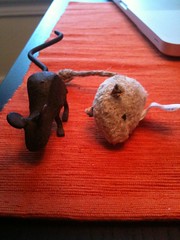It’s a sunny day here in Ann Arbor. My routine on mornings like this is to go out and look at my garden. Days when the first thing that I see are flowers and ferns busting up through last autumns fallen leaves are good days. I’ve made myself some coffee, roasted by my neighbor John Roos who sells this fair trade organic coffee in brown paper packages with individually silk-screened labels. I take my coffee outside and stumble around my yard, forcing my eyes open and encouraging the squirrels not to desolate the ornamental grasses as much this year.
Since last December these small ambles have an extra poignancy. Last December my cat Tiamat died. I’d lived with her for 15 years and she had become one of my best friends. I buried her in the fortunately thawed soil and planted wildflowers around her grave the next spring. The wildflowers are not in bloom yet but I still stop at the stacked flagstone grave marker and remember my friend. I remember holding her in my arms, bawling, as the vet euthanized her. It’s still strange to me that I could choose the date of Tiamat’s death, that it would have been cruel not to end her suffering. But that’s the asymmetrical pattern of animal human relationships. That’s been the pattern for 15,000 years.
I eat meat, it is ethical to eat meat, because of my relationship to animals. The long history of domestication is one in which humans and animals have bound ourselves together in a strangely beautiful and codependent dance of mutual suffering and flourishing. My participation in that dance is one that I am morally obligated to continue. If I did not eat meat, and use animal products, whole species would vanish from the earth.
I do not keep meat in my house, mostly because my wife and I are perfectly happy eating vegetables. But I do eat meat without hesitation, in restaurants, at the college where I teach, and in the homes of friends. Not exactly without hesitation. I usually say a small, silent, eyes-open prayer upon the flesh I am about to consume commending the soul of the creature I am about to eat into God’s hands. I believe that all creatures have souls. I will argue at the Society of Christian Ethics in January that animals are persons, that because they promote human community they are in fact better candidates for personhood than corporations. We should eat animals because they are like us, and because we are like them.
Dogs and humans behave more like each other than humans and other primates. 15,000 years of coevolution has made us resemble each other. That process is not solely one of humans shaping animal destiny. We are also shaped by the “choices” of the animals that we live with. It is a reasonable choice for the pig, the cow, the chicken to live under human protection in exchange for food. It is a reasonable choice for the lamb to give of her wool, her life, to live in human community.
Death is not a barrier to the flourishing of relationship. In fact, as I am reminded this Good Friday, sometimes death makes relationship possible. And it is not animals alone who suffer at human hands. One example, shared diseases like rabies or toxoplasmosis, must suffice.
This is not an argument for cannibalism, for humans eating dogs or for pigs eating humans. Relationships between different animals occur in different ways and are honored in different ways. It is an argument against all factory farming, and for intimate animal husbandry. It may be that eating animals is outdated, that our relationship can grow beyond consuming their flesh to solely using their products. Perhaps this is only an argument for eating pigs. Perhaps we should keep pigs as pets, or in zoos and be done with our carnivorousness. There is a part of me that would be made very happy by that shift.
But that shift would not own the ways in which humans and animals have chosen each other in time and space. It would not own the different ways we are in relationship.
….
This is a longer version of an essay I’ll submit to a NYT contest on why it is ethical to eat meat. Thanks to Jennifer Arnold for suggesting I’d have something to say.


